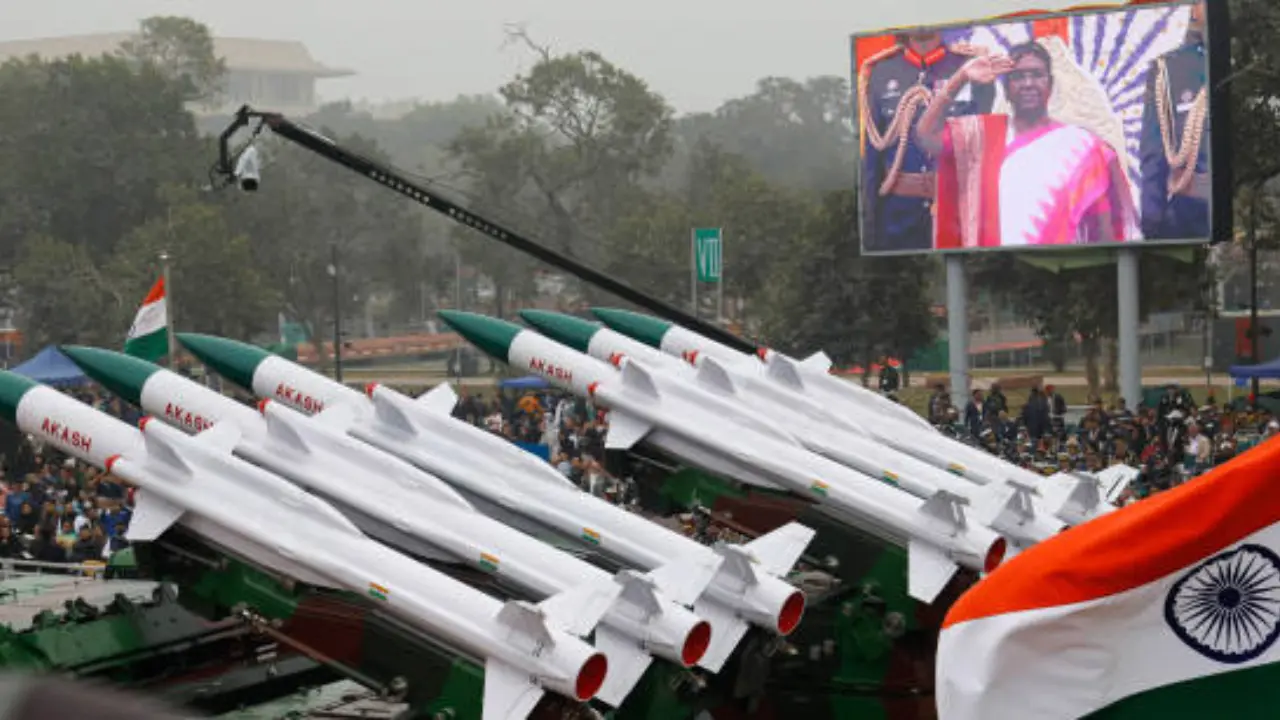The Akash Weapon System (AWS) is a short-range surface-to-air missile (SAM) system developed by India’s Defense Research and Development Organization (DRDO) and produced by Bharat Dynamics Limited (BDL). It is designed to protect vulnerable areas and points from air attacks by helicopters, fighter aircrafts, UAVs and other aerial threats. The AWS can simultaneously engage multiple targets in group mode or autonomous mode, with high immunity against electronic countermeasures. The AWS is fully mobile and can be transported by road or rail, with quick mobilization and deployment capabilities.
Development and History
The journey of the Akash Weapon System began in 1990, when the first test flight of the missile was conducted. Over the years, extensive development and testing took place, leading to the successful integration of the system into the Indian military’s arsenal. The development cost of the Akash missile system, amounting to ₹1,000 crore, was significantly lower than similar system developments in other countries. This cost-effective approach has allowed India to enhance its air defence capabilities without relying on costly imports.
System Overview
The Akash Weapon System comprises various components, including the Rajendra Radar, launchers, command posts, and supporting vehicles. Each Akash battery consists of four self-propelled launchers, a Battery Level Radar (BLR) known as Rajendra, and a Command Post (Battery Control Centre). These elements work in tandem to provide comprehensive air defence coverage for an area of 2,000 km².
The Rajendra Radar serves as the system’s fire control radar, capable of tracking up to 64 targets and guiding eight missiles simultaneously. It is equipped with advanced electronic counter-countermeasures (ECCM) features, ensuring effective target acquisition and tracking. The radar’s data is processed by the Command Post, which coordinates missile engagements and assigns targets to the Akash Firing Unit.
Components of the AWS
The AWS consists of four main components:
- The Akash missile: The missile is the main weapon of the AWS. It has a length of 5.87 m, a diameter of 35 cm, and a weight of 710 kg. It has a solid booster with an air-augmented rocket and a ramjet sustainer motor, which gives it a maximum speed of Mach 3. It has a range of 4.5 to 25 km and an altitude of 100 to 20 km. It has a 60-kg high-explosive, pre-fragmented warhead with a radio proximity fuse. It has a command guidance system with a datalink for mid-course guidance and an active radar homing system for terminal guidance.
- The Rajendra radar: The radar is the surveillance and fire control radar of the AWS. It is a 3D passive electronically scanned array (PESA) radar that can track up to 64 targets and guide up to 12 missiles simultaneously. It has a detection range of 80 km and an engagement range of 60 km. It has an antenna mounted on a rotating platform, which gives it 360-degree coverage. It has built-in electronic counter-countermeasures (ECCM) features.
- The Launcher: The launcher is the platform that carries and launches the Akash missiles. Each launcher has three ready-to-fire missiles on a single rail. The launcher can be mounted on a tracked vehicle (T-72 or BMP-2 chassis) or a wheeled vehicle (Tata Motors Heavy Mobility Trucks). The launcher has an elevation range of -10 to +70 degrees and an azimuth range of +/-45 degrees.
- The Battery Control Center (BCC): The BCC is the command post of the AWS. It is responsible for coordinating the operations of the Rajendra radar and the launchers. It receives target information from the radar and assigns missiles to the launchers. It also monitors the status of the missiles and the launchers and provides communication links with higher echelons.
Missile Capabilities
The Akash missile, the core component of the Akash Weapon System, is a surface-to-air missile with an intercept range of 25 km. It is propelled by an integrated ramjet-rocket propulsion system, providing sustained thrust throughout its flight. The missile’s advanced guidance system, coupled with its maneuverability, enables it to engage targets with high accuracy and effectiveness.
With a launch weight of 720 kg and a length of 5.78 meters, the Akash missile carries a 60 kg high-explosive, pre-fragmented warhead. It is capable of reaching altitudes of up to 20 km and speeds of Mach 2.5. The missile’s digital proximity fuse ensures precise detonation, while its self-destruct mechanism enhances safety and prevents unauthorized use.
Operational Capabilities
The Akash Weapon System has demonstrated its operational capabilities through various exercises and live engagements. During the recent Exercise Astrashakti 2023, the Indian Air Force successfully showcased the firepower of the Akash missile system by engaging and destroying four unmanned aerial targets simultaneously. This achievement establishes India as the first country to demonstrate such capability at such ranges using a single firing unit.
The Akash system’s mobility and versatility make it suitable for a wide range of operational scenarios. It can be deployed by rail, road, or air, providing air defence coverage for vital assets, military formations, and even moving convoys. The system’s ability to engage multiple targets simultaneously, combined with its quick setup and high mobility, ensures the protection of critical assets in dynamic operational environments.
Comparison with Other Air Defence Systems
The AWS is one of the few indigenous air defence systems in the world, along with systems like Israel’s Iron Dome, Russia’s S-400 and China’s HQ-9. The AWS has some advantages and disadvantages compared to these systems, as shown in the table below:
| System | Country | Range | Altitude | Speed | Guidance | Mobility | Cost |
|---|---|---|---|---|---|---|---|
| AWS | India | 4.5-25 km | 100-20 km | Mach 3 | Command + Active Radar | High | $500K |
| Iron Dome | Israel | 4-70 km | <16 km | Mach 2 | Command + Electro-optical | High | $50K |
| S-400 | Russia | 40-400 km | <30 km | Mach 14 | Inertial + Active Radar | Medium | $2M |
| HQ-9 | China | 50-200 km | <30 km | Mach 4.2 | Inertial + Semi-active Radar + Active Radar | Medium | $1M |
As can be seen from the table, the AWS has a shorter range and altitude than the other systems, but it has a higher speed and mobility. It also has a lower cost per missile than the other systems, making it more affordable for mass deployment. The AWS has a dual guidance system, which combines command guidance with active radar homing, giving it more accuracy and reliability than systems that rely on only one type of guidance.
Indigenous Advancements
The development and deployment of the Akash Weapon System exemplify India’s commitment to indigenous defence production. The system’s indigenous design and production have not only strengthened India’s self-reliance but have also resulted in significant cost savings. The Akash Weapon System has saved ₹34,500 crore in foreign exchange for India, reducing the nation’s dependence on costly imports.
Furthermore, the Akash missile system has garnered international recognition and interest. Its success has paved the way for potential export opportunities, with countries in Southeast Asia and the Middle East expressing interest in acquiring the indigenous air defence system. The constant upgrades and advancements by the DRDO scientists involved in the project ensure that the Akash Weapon System remains at the forefront of air defence technology.
Conclusion
The AWS is suitable for defending small to medium-sized areas from low to medium-altitude threats, such as helicopters, fighter jets, UAVs and cruise missiles. It can also be used as a point defence system for protecting vital installations or convoys from aerial attacks. The AWS can complement other long-range air defence systems, such as India’s S-400 or Barak-8 systems, by providing layered defence against different types of threats.
The Akash Weapon System stands as a testament to India’s technological advancements in the field of air defence. Developed indigenously by the DRDO, the system has showcased its capabilities through successful engagements and exercises. With its ability to engage multiple targets simultaneously and its mobility, the Akash Weapon System provides a robust air defence solution for India’s military formations, critical assets, and strategic locations. As India continues to strengthen its indigenous defence capabilities, the Akash Weapon System remains a cornerstone of its air defence strategy, safeguarding the nation’s skies and enhancing its self-reliance in the field of defence technology.



